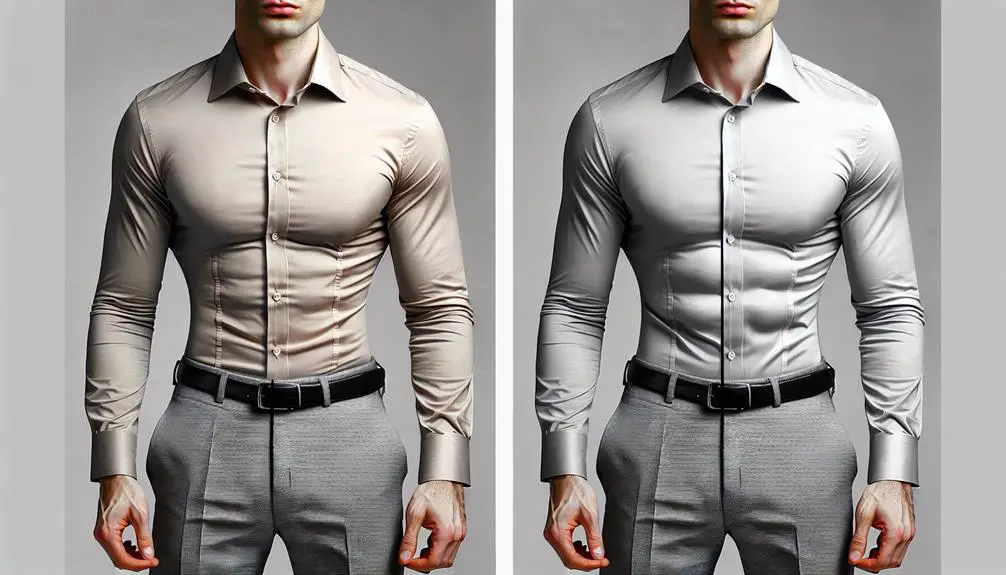So, you think you've figured out the whole fitted versus slim fit conundrum, huh? Well, hold on to your well-tailored sleeves because there's more to this fashion face-off than meets the eye.
From the subtle differences in silhouette to the nuanced styling tips, we're about to uncover the secrets behind these two popular cuts. Let's unravel the intricacies of fit and form, and discover which one truly reigns supreme in the world of style.
Table of Contents
Key Takeaways
- Fitted fit emphasizes tailoring for a sleek appearance, while slim fit creates a streamlined look.
- Slim fit offers better mobility than fitted fit, balancing style and comfort effectively.
- Slim fit complements pear-shaped figures, while fitted fit suits athletic body types.
- Choosing between fitted and slim fit should consider body shape compatibility and occasion formality.
Understanding Fitted Clothing
When I slip into a fitted shirt, I immediately notice how snugly it hugs my body, accentuating my silhouette in a flattering way. The magic behind this perfect fit lies in the tailoring techniques and fabric manipulation used to create these garments. Tailoring methods play an essential role in ensuring that the fitted shirt drapes elegantly over the contours of the body, giving it a sleek and polished appearance.
Fabric manipulation is another key element that contributes to the impeccable fit of fitted clothing. Fabrics are carefully cut and sewn in a way that enhances the natural shape of the body, offering both comfort and style. Whether it's darting to cinch in the waist or strategically placed seams to elongate the legs, every detail is meticulously designed to create a garment that not only fits well but also looks effortlessly chic.
Understanding these tailoring techniques and fabric manipulation methods sheds light on the intricate craftsmanship that goes into creating fitted clothing. The result is a garment that not only fits perfectly but also makes you feel confident and stylish.
Characteristics of Slim Fit
Let's break down what makes a slim fit garment stand out.
The definition of slim fit clothing emphasizes a close-fitting design that contours the body.
The silhouette of slim fit pieces typically features narrower sleeves and a tapered waist for a modern look.
Slim Fit Definition
Slim Fit clothing is known for its snug and tailored silhouette that accentuates the body's contours. When it comes to creating this sleek look, tailoring techniques and fabric manipulation play an essential role. Here are some key characteristics of Slim Fit clothing:
- Close-fitting: Slim Fit garments hug the body closely without being overly tight.
- Narrow Sleeves: Sleeves on Slim Fit shirts and jackets are tapered for a streamlined appearance.
- Reduced Excess Fabric: The design minimizes any unnecessary bulk or bagginess.
- Defined Waist: Slim Fit clothing often features a more pronounced waistline for a modern and tailored look.
Slim Fit Silhouette
Moving from the snug and tailored characteristics of Slim Fit clothing, the Slim Fit silhouette emphasizes a sleek and streamlined appearance through its specific design features. Slim fit tailoring focuses on creating a close fit to the body, accentuating its natural shape without being overly tight. This silhouette is tailored to follow the contours of the body, providing a modern and stylish look.
Keeping up with slim fit trends guarantees that the clothing remains fashionable and up to date. Understanding your slim fit body measurements is essential for achieving the perfect fit, and slim fit alterations can be made to customize the clothing to your specific preferences. Embracing the slim fit silhouette allows you to showcase a sophisticated and polished style with a contemporary edge.
Slim Fit Comfort
For those seeking a tailored look with a touch of snugness, slim fit clothing offers a balance between style and comfort. When it comes to slim fit comfort, here are some key characteristics to take into account:
- Stretch Fabric: Slim fit clothing often incorporates stretch fabric, allowing for ease of movement without sacrificing the tailored silhouette.
- Breathable Materials: Opting for slim fit pieces made from breathable materials helps maintain comfort throughout the day.
- Tailored Design: The close fit of slim fit garments is designed to follow the body's contours, providing a modern and sleek appearance.
- Versatile Styling: Slim fit clothing can be dressed up or down, making it a versatile choice for various occasions.
Tailoring Techniques for Fitted Garments
When tailoring fitted garments, precision in stitching and fabric manipulation are key techniques that guarantee a perfect fit.
Stitching precisely along seams helps in shaping the garment to the body, while manipulating the fabric strategically can enhance the overall fit and silhouette.
These techniques are important in achieving a tailored look that complements the wearer's body shape.
Stitching Precision for Fit
With meticulous attention to detail, tailors employ specific stitching techniques to guarantee a precise fit for tailored garments. When it comes to precision stitching for a tailored fit, here are some key techniques to look out for:
- Flat-Fell Seams: These strong and neat seams are commonly used in high-quality garments to make sure durability and a clean finish.
- Understitching: By securing the seam allowance to the lining, understitching helps maintain the shape and structure of the garment.
- Topstitching: This visible stitching not only adds decorative elements but also reinforces seams for longevity.
- Blind Hem: A nearly invisible hemming technique that provides a polished look without compromising on strength and durability.
Fabric Manipulation for Fit
Utilizing precise fabric manipulation techniques is essential in tailoring fitted garments to guarantee a flawless and personalized fit. When it comes to fabric draping, strategically positioning the fabric on a dress form allows for a visual representation of how the garment will fall on the body. This method helps in understanding how the fabric will behave once worn and aids in making necessary pattern alterations.
Pattern alterations play an important role in achieving a perfect fit. Adjusting the pattern to match the unique measurements and proportions of the wearer guarantees that the final garment hugs the body in all the right places. By combining fabric draping with meticulous pattern alterations, tailors can create bespoke fitted garments that are both comfortable and stylish.
Differences in Silhouette
In comparing fitted and slim fit clothing, the silhouette plays a key role in distinguishing between the two styles. When it comes to silhouette comparison between fitted and slim fit garments, there are subtle yet important differences that impact how each style looks and feels when worn.
- Fit Precision: Fitted clothing is tailored closely to the body, emphasizing curves, while slim fit offers a more streamlined look without being as body-hugging.
- Mobility: Slim fit allows for a more modern silhouette while still providing ease of movement, whereas fitted clothing may restrict mobility due to its closer cut.
- Tailoring Techniques: Fitted garments often employ intricate tailoring techniques to achieve a snug fit, while slim fit focuses on a cleaner, more tapered appearance.
- Comfort: Slim fit strikes a balance between a tailored look and comfort, whereas fitted garments prioritize a sleek aesthetic over comfort.
Understanding these differences can help in choosing the right fit for your style preferences and body shape.
Styling Tips for Slim Fit
Moving from the differences in silhouette between fitted and slim fit clothing, let's explore some practical styling tips to make the most of your slim fit pieces.
When it comes styling slim fit clothing, considering both styling versatility and current fashion trends is crucial. Experiment with layering different pieces to create depth and dimension in your outfit. Pair slim fit pants with a loose, flowing top for a balanced look, or try a fitted shirt with a structured blazer for a more polished appearance.
Body confidence plays a significant role in pulling off slim fit styles. Embrace your shape and wear pieces that make you feel good about yourself. Remember, personal preferences are key. If you prefer a more tailored look, opt for slim fit pieces that highlight your physique. On the other hand, if you like a bit more room in your clothing, choose slim fit items that offer a slightly looser fit while still maintaining a streamlined silhouette.
Comfort and Mobility Comparison
Let's explore how comfortable and mobile you can feel when wearing both fitted and slim fit clothing styles.
- Range of Motion: Fitted clothes may restrict movement slightly, especially in areas like the shoulders or thighs, whereas slim fit allows a bit more room for natural motion.
- Fabric Choice: The type of fabric used can greatly impact comfort. Breathable materials like cotton or linen can make both fitted and slim fit styles more comfortable for all-day wear.
- Mobility: Slim fit garments generally offer better mobility due to their slightly looser cut compared to fitted clothes, which can sometimes feel restrictive during activities.
- Comfort Trade-Off: While fitted styles provide a sleek and tailored look, they can sacrifice some comfort for aesthetics. On the other hand, slim fit strikes a balance between style and comfort, making it a versatile choice for various occasions.
Suitability for Various Body Types
When considering different body types, it is crucial to assess how well fitted and slim fit clothing styles complement varying shapes and sizes. Body shape compatibility plays a significant role in determining whether a fitted or slim fit garment will look flattering on an individual. Fit customization is crucial for achieving the best look, as it allows for adjustments that cater to specific body shapes. Size variations also play a key role, with certain body types benefiting more from one fit than the other.
To illustrate this further, let's break down the suitability of fitted and slim fit styles for various body types in the table below:
| Body Type | Fitted Fit | Slim Fit |
|---|---|---|
| Athletic | ✔️ | |
| Pear-Shaped | ✔️ | |
| Tall and Slim | ✔️ | |
| Broad Shoulders | ✔️ |
Understanding how fitted and slim fit styles align with different body shapes can help individuals make informed decisions about which option will suit them best.
Choosing the Right Fit
To find the perfect fit for your body type, consider trying on both fitted and slim fit styles to see which one complements your shape best. When it comes to choosing the right fit, here are some key points to keep in mind:
- Fit Comparison: Take note of how the fitted and slim fit styles hug your body. The fitted style tends to be more form-fitting, while the slim fit offers a slightly more relaxed silhouette.
- Style Selection: Think about the occasion you're dressing for. Fitted styles are great for a more formal look, while slim fit can be versatile for both casual and semi-formal settings.
- Comfort Level: Pay attention to how comfortable you feel in each style. Striking a balance between a flattering fit and ease of movement is crucial.
- Personal Preference: Ultimately, choose the fit that makes you feel confident and suits your personal style best. Your comfort and confidence are key in pulling off any look effortlessly.
Frequently Asked Questions
How Do Fitted and Slim Fit Clothing Differ in Terms of Fabric Stretch and Comfort?
When it comes to fabric stretch and comfort, fitted clothes provide moderate stretch and comfort, while slim fit garments offer a snugger fit with less stretch but potentially more tailored comfort. Fabric breathability and stretch retention play key roles in determining comfort.
Are There Specific Body Types That Are Better Suited for Fitted Clothing Over Slim Fit?
Certain body shapes may find fitted clothing more flattering due to its tailored silhouette. Personal preferences play a role in styling choices, and staying updated on fashion trends can help in deciding between fitted and slim fit.
Can Tailored Garments Be Altered to Transition From Slim Fit to Fitted or Vice Versa?
When considering adjustments, tailored garments can often change between slim fit and fitted styles based on personal preferences, fashion trends, and body changes. Explore alteration options to adapt your clothing to your evolving style.
Do Fitted and Slim Fit Clothing Require Different Care Instructions When Washing and Drying?
When it comes to caring for fitted and slim fit clothing, it is crucial to follow proper washing and drying instructions to maintain fabric durability, prevent shrinkage, avoid color bleeding, and use appropriate ironing techniques for a crisp look.
Are There Certain Occasions or Events Where Slim Fit Clothing Is More Appropriate Than Fitted Clothing, and Vice Versa?
For various occasions, fashion trends often influence my choice between slim fit and fitted clothing. Personal style and body type play a significant role. Finding the right balance guarantees confidence and comfort in different settings.
- Tetron Fabric for Marine Applications: Durability and Use Cases - June 18, 2025
- Tetron Fabric for Outdoor Furniture: Weather Resistance and Care - June 18, 2025
- Tetron Fabric for Wall Coverings: Style and Application Tips - June 18, 2025







